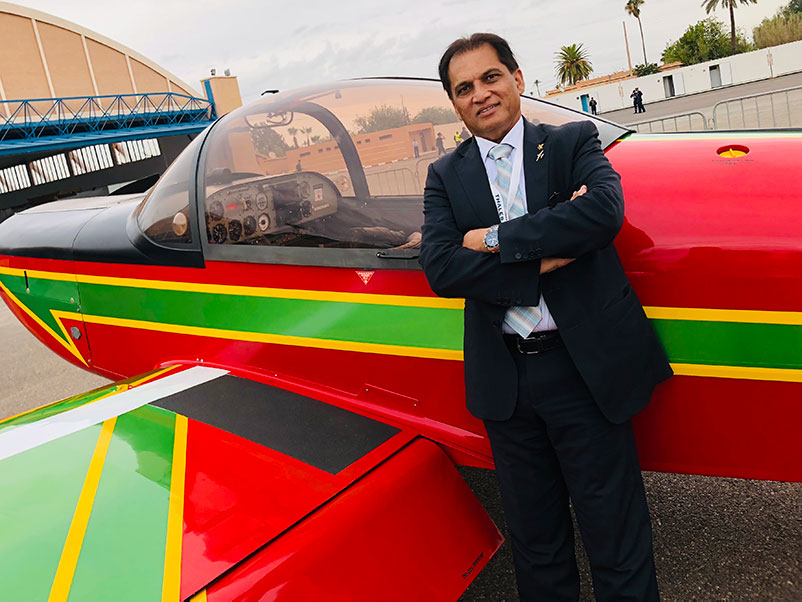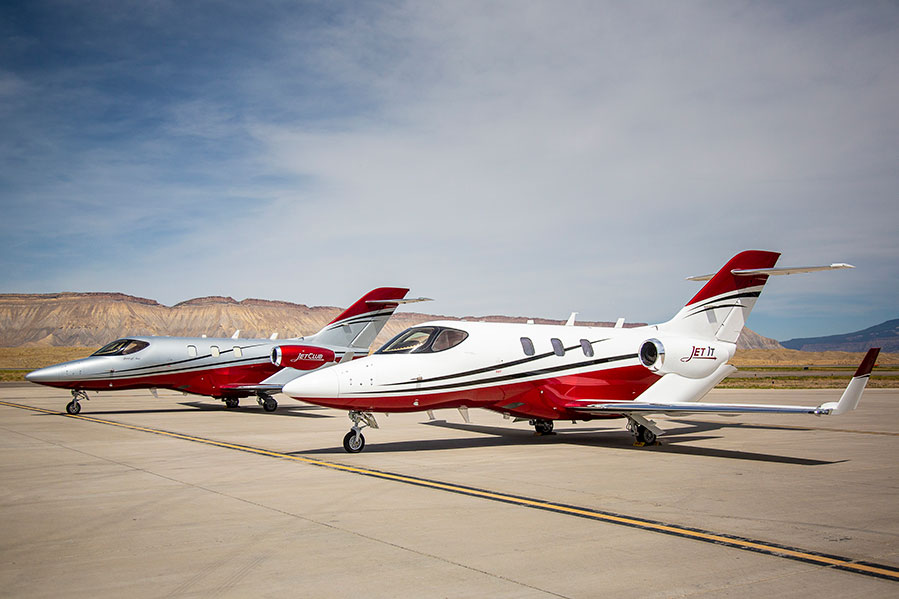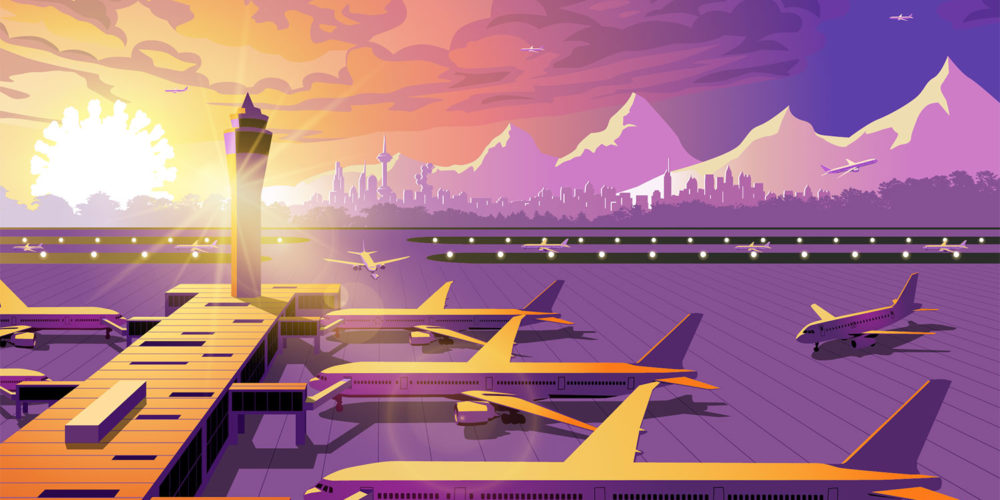Few industries have been hit as hard by the global pandemic as commercial aviation. For more than a year, freefalling demand in passenger traffic, job losses and multi-billion-dollar cash burns have tested the mettle of an industry that has seen its share of existential challenges.
“This isn’t just a blip. This is a sustained 9/11,” says Kelly George (’15), associate professor at Embry-Riddle. “U.S. airlines were burning $10 billion in cash per month.”
But the industry is proving itself tough. From launching vaccination and hygiene programs that protect people and planes from viral threats, to developing innovations in aircraft inventory and crew management, the industry is finding ways to adapt.
Not surprisingly, Embry-Riddle alumni have been on the front lines, playing key roles to serve the industry in its time of greatest need.
Lift reached out to several alumni to get their take on the struggle, what they’ve learned and what we can expect in the wake of COVID-19.
Widening the Safety Net
When the pandemic hit, the scope of flight safety management widened quickly. The discipline that historically focused on things like maintenance, pilot fatigue and passenger movement, suddenly also had to address a deadly virus that may not show symptoms for weeks.
David Zwegers (’98, ’10) says adapting to this new threat was straightforward. Zwegers served as regional safety director at Airbus for seven years, leaving the company in March 2021 to become director of global safety strategy at The Boeing Company.

“Called the ‘Keep Trust in Air Travel’ initiative, it switched from collecting flight data to health data, to learn how to mitigate risk,” Zwegers says. “It’s the same approach we have always taken to safety risk management, just with different data points.”
Much of that data collection dealt with cabin airflow, plus cleaning and disinfection procedures. A study published by the International Air Transport Association (IATA) in October 2020 determined, through analyses conducted by Airbus, Boeing and Embraer, that the likelihood of COVID-19 transmission in an aircraft is very low when passengers also wear masks.
“We pooled our internal and external resources to share knowledge of systems on the aircraft and knowledge of the virus to eliminate the risk of spread,” Zwegers says. “It was critical to help airlines reduce their impact because many CAAs [civil aviation authorities] were taking measures that were more politically driven than fact-driven.”
Aircraft manufacturers also had to quickly review new cleaning and disinfection methods that had not been tested in aircraft before. Airbus rapidly tested electrostatic fogging, ultraviolet light and many chemicals to see if these methods would reduce virus propagation and be safe for the aircraft. Zwegers expects that the increased demand for antibacterial surfaces, as well as touchless features to operate faucets, toilets and doors, will continue long term.
He adds that safety will expand to include the entire travel experience, from home to destination. “Safety in the air transport system itself requires a collaboration of all stakeholders. We all work together. We don’t compete on safety.”
Shifting Against the Headwinds

With passenger air travel down as COVID-19 took hold, aircraft maintenance, repair and overhaul (MRO) organizations felt the ripple effect and promptly adjusted their business models.
“The impact of COVID was unique,” says Ed Onwe (’12), vice president and general manager of VT San Antonio Aerospace, a global leader in aviation maintenance. “Significant portions of the world’s cargo go in the belly of passenger airliners. So when passenger travel declines, the opportunity to move cargo declines. To correct that, there has to be an increase in cargo lift. That gave us an opportunity to shift our focus to [maintaining] cargo airliners instead of passenger airliners, but the net effect is a decline of 20 to 30% in work volume.”
Amyr Qureshi (’85, ’86), senior vice president and co-founder of Aventure Aviation, says this unique situation created an opportunity for parked passenger aircraft to be converted to cargo use. “The honeymoon period right now is more for the conversion facilities that are converting passenger aircraft into freighters. They have a long backlog of orders for converting these aircraft.”
But the demand for cargo isn’t strong enough to make use of all the excess aircraft in the industry. Qureshi says that some airlines are salvaging their own parked aircraft for spare parts or making drastic cuts to their fleets altogether, which is having ripple effects on the aircraft parts sales side of his business.
“Airlines are deciding to retire their aging airplanes much sooner than planned, lessen their cost structures and maximize their revenues,” Qureshi says. “This trend is bound to continue for the next four to five years simply because of the evolving market conditions leading to fleet optimizations.”

Qureshi says the resulting glut of harvested and reconditioned parts on the market compelled them to run a strategic analysis of the industry looking forward. Their conclusions called for Aventure Aviation to scrap parts inventory for older generation aircraft. “We are shifting toward building parts inventory for more efficient new-generation aircraft, as well as for some common 757, 767, 777 freighters that are surely destined to fly for years ahead on medium- to long-haul routes,” Qureshi says.
Though parked aircraft are slowly being brought out of storage to meet some rising demand, Qureshi predicts that many operators will scrap older airframes and buy more efficient, new-generation aircraft.
“Many airplanes will never be airborne again,” Qureshi says. “You can blame this on the pandemic, no doubt about it.”
The Human Element
When it comes to addressing safety in a pandemic, aircraft are only part of the equation. The human element is vital. Keeping the industry aloft begins with protecting the health of crews and passengers.

Vaccines are a frontline solution, and airlines are eager to vaccinate workers. Shareef Al Romaithi, Ph.D. (’05, ’06, ’14), a captain for Etihad Airways, was among the first to participate in his airline’s efforts to have all of its crew members fully vaccinated — a measure taken to ensure the safety of its passengers and crews.
“I was very confident about taking the vaccine” says Al Romaithi, who is also head of corporate safety at Etihad. “As I work on the frontline, the vaccine gives me an additional peace of mind to safely operate commercial flights.”
He credits his confidence in receiving the vaccine to the cooperation between Etihad Airways and the UAE government.
“Strong collaborations between Etihad and the UAE government ensured that all pilots and cabin crew were vaccinated in the shortest time possible. It is a great moment of pride,” Al Romaithi says. “We are doing our part by getting vaccinated, and the sooner we all get vaccinated, the sooner we will get through this. We are all in this together.”
A Question of Balance
It’s that “all-in-this-together” approach that’s helping companies and their employees weather the storm. Elisabeth Matschnigg (’20), assistant manager of ground operations audits at IATA, says that the way companies balance employee mental well-being with the bottom line is a critical factor in their adaptability.
Operational Safety Goes Virtual
Elisabeth Matschnigg (’20), assistant manager of ground operations audits at the International Air Transport Association (IATA), says that though infectious disease was not directly addressed in prior auditing procedures and emergency response plans, the industry and regulators were quick to meet the need for working guidelines in response to COVID-19.
“Despite the tough times, we were very innovative. There’s this reputation that bureaucratic organizations have for being slow — and the same applies for regulators and governments. But they [the FAA, International Civil Aviation Organization, and civil aviation authorities] were very good at issuing guidance early and adjusting policies to match reality very fast,” she says.

IATA member airlines who were coming due for an onsite operational safety audit during the early days of the pandemic, when travel restrictions were severe, were given an extension while the IATA worked with regulators to firm up the remote-audit option. Matschnigg expects that remote audits will likely influence the future of audit programs even after the pandemic ends.
“We’re getting very good at working remotely, and in many cases, it has brought our teams closer and made us more efficient,” Matschnigg says. “It shows how versatile and adaptable we are, that when we have to be quick to make sure operations continue safely, we find a way to do it.”
“If people are worrying about job security, the economic welfare of their company, dealing with stress from prolonged periods at home, this can reduce the fulfillment of your work. If you [as an organization] don’t address this on all levels, it can show in overall performance and the financial bottom line,” she says. “It’s always a balanced approach — obviously the company going bankrupt helps no one. But if employees see your support, they will want to support you.”
At IATA, Matschnigg highlights their internal “Are You Okay?” initiative, which includes surveys on mental well-being. “We had a restructure; we had to let people go. The survey asks how [they] are coping with that, how has [their] workload changed. This has been a big focus in organizations and has become more important than ever.”
Singapore Airlines embraced a similar approach to help address the well-being and professional needs of their employees. Rick Wee (’15), senior executive of Cabin Crew Safety, Security, Quality and Health at Singapore Airlines, says they sought special permission from the nation’s civil aviation authority to use online programs to keep crew current on their 60-day operational and flight frequency requirements. In addition to investing in these measures, Singapore Airlines encouraged employees to volunteer locally, both to support their country and develop new skills.
“We provided crew to government institutions that were in need of resources, in areas such as healthcare, transport and contact tracing. The Crew Ambassador Programme was a win-win situation, as the role and training of the cabin crew enabled them to contribute to these establishments,” Wee says.
When the difficult reality of staff reductions became necessary in September 2020, the airline waived their exclusive employment restrictions on cabin crew and assisted them in finding temporary work. They also introduced a COVID-19 Voluntary Release Scheme to offer their cabin crew an option for early release or retirement with payouts and benefits. As flights gradually continue to resume, their “seconded crew” are starting to return to work at the airline.
Embracing Resiliency

Delta Air Lines was able to avoid involuntary furloughs by leveraging its existing resiliency strategy to secure employee buy-in, says Marquita Pfannenstiel (’04), manager of domestic inventory management at Delta.
“We [were already] trying to make ourselves more resilient as an organization,” Pfannenstiel says. “We wanted to withstand dramatic changes in demand and the economy. And we had been on that journey for a long time.”
Jay Sterioff (’79, ’83), a senior captain who has been with Delta for 31 years, also feels that the company’s approach was an important part of the pandemic response.
“I believe Delta recognized the issues very quickly, and I think they responded intelligently and thoughtfully and virtually immediately,” Sterioff says. “It helped balance the issues that everyone was concerned about in the industry.”
That balance involved securing the cooperation of Delta employees. According to company statements, more than 40,000 Delta employees took a voluntary unpaid leave of absence and nearly 17,000 retired early or left the company with benefits packages.
Pfannenstiel credits this proactive, cooperative approach in difficult times as the defining factor in Delta’s ability to recover, including the ability to avoid involuntary furloughs.
“We did the absolute best we could for people,” Pfannenstiel says.
While pay cuts, mass furloughs and retirements have left newly certificated pilots with few current prospects in a pandemic-ravaged industry, Sterioff remains hopeful for the young pilots just getting their start.
“I would say to anybody who is pursuing [a pilot] career that I think it’s a tremendous career,” Sterioff says. “I think it had a setback. The entire world has had a setback. But you are going to see a continual uptick and a huge demand for pilots going forward. I think that you’re going to see an improving economy and see things that hopefully will allow us to put this behind us.”

Right Place, Right Time
Not all sectors of the industry have struggled during the pandemic. A fortunate few were in the proverbial right place (or right sector) at the right time. Case in point: Glenn Gonzales (’11), CEO and founder of Jet It, a hybrid fractional provider.
“For private aviation, it’s actually been a bit of a boon for us. The pandemic has definitely increased awareness as people are looking for different means of travel,” Gonzales says. “The industry is evolving, and I think it’s just accelerating the inevitable.”
Gonzales launched his hybrid fractional ownership business in 2018. It offers a day-use model that allows for travel to multiple destinations in one day and fractional ownership options of one-tenth (25 days) to one-half (130 days) of a HondaJet Elite. It’s called a hybrid program because owners who are pilots and have a type rating for the HondaJet can fly as co-pilots in the Red Jet Squadron. The Jet It fleet is also available for charter flights.
“I noticed a gap in the market” Gonzales says. “I created a business model that met the market demand, and I was fortunate to have Harvard [University] select Jet It for a case study and incorporate us into their academic curriculum.”

In executing their vision, Gonzales and Jet It’s co-founder, Vishal Hiremath, have executed operations in three regions: the United States, Canada and the European Union. They are making preparations to launch in India and Southeast Asia in 2022. The company has gained global attention for its focus and innovation in travel.
While it may take some time, Gonzales expects people’s innate need for connection to induce a rebound in business air travel.
“At the end of the day, when closing a deal, there’s that human element that does not go away,” Gonzales says. “There’s something about the essence of another person that you cannot feel online. You need to look them in the eye, in person, and shake their hand. That will never go away as far as I’m concerned; it’s a human behavior that does not change.”
